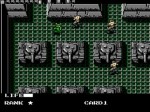
Solid Snake is one of the most recognizable characters in gaming as well as everyone’s favorite spy. He has gone numerous missions over his long career, fighting terrorists, militant armies, and the dreaded Metal Gear. For this week’s Time Warp Review, yours truly, Devildriver1313, is going to take a look back at Snake’s early career. Join me in celebration of the 30th Anniversary of the original Metal Gear.

Hideo Kojima developed the first game in the series after being asked by a senior associate to take the project over. Metal Gear was intended to be a military combat game, but the MSX2’s hardware was limited, unable to handle a large number of enemies and bullets on-screen. Feeling that this would impede the combat aspect, Kojima shifted focus from shooting down the enemy to avoiding capture. Metal Gear, which had the title “Intruder” during the early stages of development, was originally released for the MSX2 home computer in Japan on July 13, 1987. The game focused on Solid Snake, a rookie member of the special forces group FOXHOUND, who is sent of his first mission into the fortified state of Outer Heaven to destroy a bipedal walking tank known as Metal Gear, which is capable of launching nuclear missiles from anywhere in the world. The player must navigate Solid Snake though enemy territory. Stealth is the key to survival. Should Snake be spotted, how he escapes is dependent upon the situation. If a single exclamation point appears over an enemy’s head, Snake can escape the on-screen enemies by simply moving to the adjacent screen. However, if two exclamation points appear, reinforcements are called in and Snake must either eliminate all of them, head outside or find an elevator. As mentioned before, the name of the game is stealth so no weapons are available at first. He must use his fists to take out enemies. But Snake does acquire a variety of weapons along the way. Each weapon has limited ammunition and can only be replenished by finding caches or supply boxes. Snake can use his weapons to clear obstacles such as hollow walls and electrified floors.

The NES version featured an extended outdoor sequence
The enemy base consists of three multi-floored buildings with basement levels. To access a new area within the base, a key card must be obtained to unlock the corresponding doors. Hostages are being held within the building and must be rescued. Doing so yielded new information and if all five hostages are rescued, the player’s rank will go up. However, if any hostages are killed, the player loses rank. Snake is always in communication with Big Boss, his commanding officer, and one of three resistance members, Schneider, Diane and Jennifer. Each member has their own special set of skills that helps Snake on his mission.

See the difference! The NES Metal Gear (on left) changed the final boss to a super computer from its original bipedal tank form in teh MSX2 version (on right)
Metal Gear was ported to the Famicom system for release in Japan on December 22, 1987 and later in North America for the NES in June the next year. Hideo Kojima was not behind the NES and Famicom ports. Another Konami division in Tokyo was given the source code with the original team or Kojima’s consent. Many changes were made during the porting process. Instead of an underwater infiltration, Snake parachutes into the jungle with three other soldiers who do not appear in the MSX2 version. Several enemy positions and functions were also changed. The jet pack wearing soldiers have lost their ability to fly, rendering them regular foot soldiers, and the Hind D boss was replaced with twin turret gunners called “Twin Shot.” The biggest change was to the Metal Gear itself which was turned into a super computer guarded by four soldiers and not the walking tank we all know nowadays. With so many profound changes, Hideo Kojima publicly disowned himself from the NES version. The MSX2 version of Metal Gear ranked #4 in the October issue of MSX magazine in 1987 and peaked at #3 the following month. This version was praised for its graphics, size of the game area and addictive gameplay. Though its graphics were “acceptable”, the NES port paled in comparison. NES Metal Gear was criticized for the control system and the player’s great vulnerability when unarmed at the start of the game. Nonetheless, the title showed great promise as it moved for the standard run, jump and shoot format of most NES games. “It was a potential hit that, sadly, was sabotaged by its own weaknesses”, according to Computer Gaming World magazine. Despite the shortcomings, the NES version Metal Gear was a success and help popularize its genre, leading to the creation of two separately produced sequels, Snake’s Revenge for North America and Metal Gear 2: Solid Snake for Japan with Kojima at the helm. The latter was followed by Metal Gear Solid for the first Playstation in 1998 which is followed by numerous sequels and spinoffs. Remakes of the original MSX2 version were penned by Hideo Kojima but he has since departed from Konami following the release of the latest (and potentially last) game in the Metal Gear series, Metal Gear Solid V: The Phantom Pain (which take places before the events of the original title), leaving the possibility of such remakes, if not the series itself, in question.
Metal Gear-MSX
Metal Gear-NES
![]()








